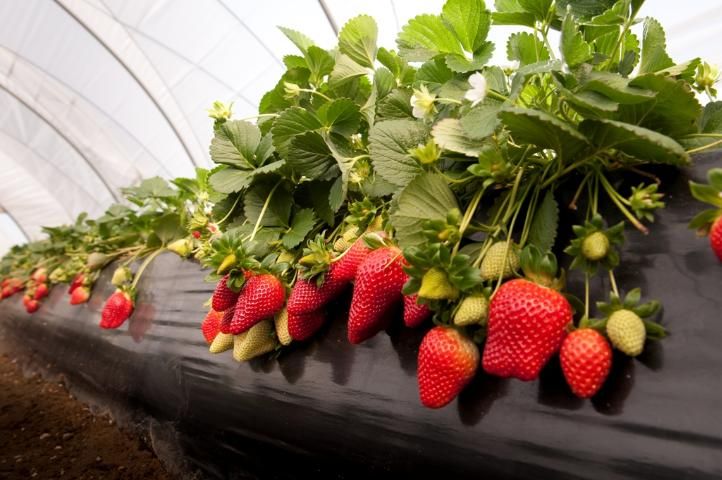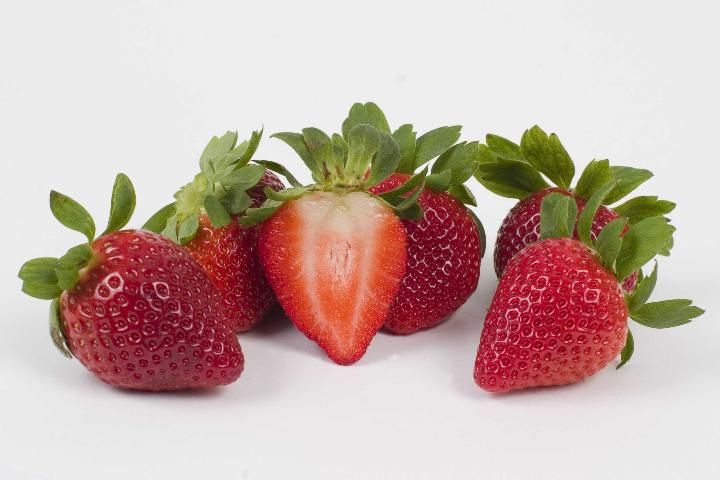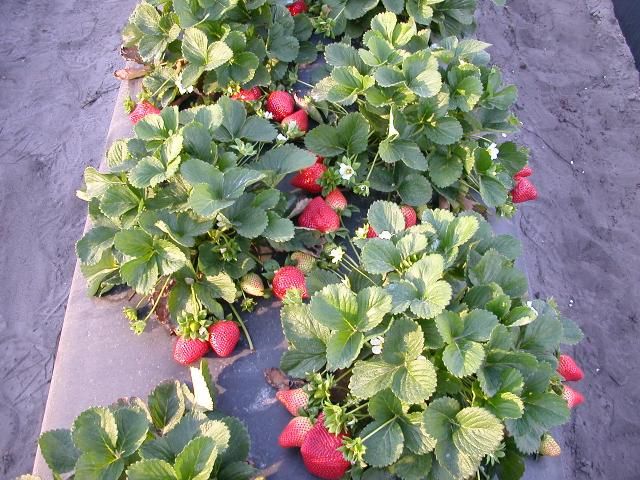Introduction
'Florida Radiance' (U.S. Plant Patent 20363) is a strawberry cultivar released from UF/IFAS in 2008 (Chandler et al. 2009). It originated from a 2001 cross between 'Winter Dawn' (female parent), a 2005 release from the UF/IFAS breeding program, and FL 99-35 (male parent). As of 2012, 'Florida Radiance' has become a major cultivar in Florida and other winter and early spring production regions worldwide, including Queensland, Australia, and southwest Spain. In all markets outside the United States and Canada, it is marketed as 'Florida Fortuna'. In addition to commercial production, it has been tested for many years in field plots at the UF/IFAS Gulf Coast Research and Education Center (GCREC) in Wimauma and the Florida Strawberry Growers Association (FSGA) headquarters in Dover for disease, fruit, and plant traits.
Data from these trials have been combined with field observations to generate the following information and recommendations to help growers obtain optimal performance from 'Florida Radiance' in west central Florida. These recommendations are specific to open-field culture in Florida, and some may not be accurate for other growing systems and regions. Throughout this publication, 'Florida Radiance' is compared to 'Strawberry Festival' (Chandler et al. 2000), the Florida industry standard for firmness, shelf life, and resistance to water damage, and to Winterstar™ 'FL 05-107' (Whitaker et al. 2012), a newer cultivar that possesses similar fruit size and early yields to 'Florida Radiance'.
Fruit and Plant Characteristics
'Florida Radiance' is highly adapted to annual, winter plasticulture growing systems. Although it is formally classified as a short-day cultivar, nursery growers have reported more flowering in nursery fields under long-day conditions than traditional short-day cultivars. The plant is moderate in size with an unusually open canopy and very long pedicels for easy harvest (Figure 1). It produces conic to long-conic fruit that are very large, uniform, glossy, and evenly colored. Very few cavities or split fruits have been observed (Figure 2).

Credit: Ekland Marketing Co. of California, Inc.

Credit: Tyler Jones, UF/IFAS Communications
'Florida Radiance' fruit size is larger than 'Strawberry Festival' and approximately equal to Winterstar™ 'FL 05-107' in the early season. However, it has larger fruit than the other cultivars late in the season and has the lowest proportion of small culls. The fruit is less firm than 'Strawberry Festival' and Winterstar™ 'FL 05-107' (Whitaker et al. 2011, 2012), though it has acceptable firmness for Florida growers under normal temperatures and management programs. 'Florida Radiance' is moderately resistant to rain damage and has a flexible skin. The fruit has a moderate acid content with a balanced flavor and is generally the juiciest of the UF/IFAS cultivars.
Field Performance
Early season yields of 'Florida Radiance' in Florida open-field culture are greater than 'Strawberry Festival' and similar to Winterstar™ 'FL 05-107'. 'Florida Radiance' late-season yields have been higher than any other UF/IFAS cultivar in most seasons. It has also yielded particularly well in high-tunnel environments worldwide and is highly recommended for protected culture systems. The recommended planting period in west central Florida is from October 5 to 15. When planted earlier in Florida and exposed to more hot weather in October and early November, it occasionally produces elongated, sometimes unmarketable berries on the second emerging inflorescence. In addition, 'Florida Radiance' has a weak plant habit and can benefit from extra chilling hours in the nursery. While it requires little chilling to initiate flower buds compared to typical short-day cultivars, increased chilling may be important to increase crown size and root mass. In-row plant spacing typically ranges from 12 to 16 inches, depending on planting date and grower preference.
Plant Establishment
'Florida Radiance' can be established from bare-root transplants available from certified and licensed nurseries. The traditional transplant practice in west central Florida uses approximately 10–12 days of sprinkler irrigation for 8–12 h/day, depending on air temperature. Growers are encouraged to reduce irrigation volumes during early October transplanting by using foliar applications of crop protectants based on either kaolin clay or calcium carbonate on the morning of the 8th day after 7 days of sprinkler irrigation.
'Florida Radiance' also performs exceptionally well as a plug plant, both in Florida and in other production regions. It requires little chilling to initiate flower buds and has a minimal gap in production compared to other traditional short-day cultivars, such as 'Strawberry Festival', when planted as a plug. A distinct advantage of plug transplants is that they require little to no sprinkler irrigation for establishment, which leads to both water savings and increased early yields.

Credit: C. K. Chandler
Fertilization and Irrigation
The fertilization program should be based on the crop requirement and the soil's natural fertility. A revision of the fertilization and irrigation practices for strawberries is available at https://edis.ifas.ufl.edu/CV134. 'Florida Radiance' is a moderate-fertilization cultivar and requires lower nitrogen (N) rates than 'Strawberry Festival'. Excess N reduces fruit quality during mid and late season. Total N and potassium (K) rates of 150–175 lb/acre during the season have resulted in excellent fruit yields from December to mid-March. Previous research has indicated this cultivar does not require preplant N fertilization (see https://edis.ifas.ufl.edu/HS370). Rather than relying on the incorporation of preplant N fertilizer, it is critical to establish 'Florida Radiance' by starting N applications through the drip tape as soon as possible after planting. This is important to develop enough crown and leaf mass to support its high early yields.
'Florida Radiance' production in west central Florida, where deep sandy soils with low organic matter are the norm, also requires careful irrigation scheduling. Florida growers successfully use lower irrigation rates for 'Florida Radiance' compared to 'Strawberry Festival', which helps to maintain fruit firmness. In most cases, drip irrigation longer than a 1 h/day (˜25 gal/acre/min or 1500 gal/acre/h) with one drip tape per bed results in nutrient leaching. During the early stages of growth in October and early November, when day temperatures are above 70°F and plants do not have a fully developed root system, it is convenient to provide one or two irrigation cycles per day totaling no more than 30 min/day (750 gal/acre). This amount varies depending on the nature of each season, and moisture on the top 6 inches of the beds should be monitored constantly using a tensiometer or other type of moisture sensor. More information about irrigation scheduling is available at https://edis.ifas.ufl.edu/CV107.
Disease Management
The resistance of 'Florida Radiance' to Colletotrichum acutatum (causal agent of anthracnose fruit rot) is superior to that of the highly susceptible cultivar 'Treasure' (Seijo et al. 2011) and also 'Strawberry Festival'. More information about anthracnose can be found at https://edis.ifas.ufl.edu/PP130. Resistance to Botrytis cinerea (causal agent of Botrytis fruit rot) is superior to that of the highly susceptible cultivar 'Camino Real', but 'Florida Radiance' is more susceptible to Botrytis fruit rot than 'Strawberry Festival' (see https://edis.ifas.ufl.edu/PP152 for more information about Botrytis). Fungicide applications for Botrytis fruit rot control should target peak bloom periods. Captevate®, Elevate®, Switch®, and Thiram are among the most effective fungicides for Botrytis fruit rot control. A web-based disease forecast system to help growers time fungicide applications for control of anthracnose and Botrytis fruit rots is available at http://agroclimate.org/tools/strawberry/. More information on the system is available at https://edis.ifas.ufl.edu/AE450.
Based on inoculation trials, 'Florida Radiance' is highly susceptible to crown and root rots caused by Phytophthora cactorum. Thus, fruit growers are strongly encouraged to take precautions against P. cactorum. Mefenoxam, the active ingredient in Ridomil Gold®, is highly effective and should be injected through the drip tape as soon as plants are established. Two applications may be needed to treat an infected crop. Products containing potassium phosphite or potassium salts of phosphorous acid are alternatives that should generally be applied as foliar sprays, although some are also labeled for drip application. Members of this group are not curative; multiple applications may be needed beginning immediately after plants are established.
Early season plant collapse can also be caused by Colletotrichum gloeosporioides (causal agent of Colletotrichum crown rot) and Macrophomina phaseolina (causal agent of charcoal rot). Symptoms are virtually indistinguishable from those of Phytophthora crown rot. Replicated inoculation trials indicate 'Florida Radiance' is more resistant to Colletotrichum crown rot and charcoal rot than 'Strawberry Festival'. To identify the causal agent of plant wilt and collapse, growers are encouraged to submit a sample to the UF/IFAS Plant Diagnostic Lab at GCREC, where the pathogen will be isolated and identified and control recommendations provided.
For Nursery Growers
'Florida Radiance' produces runners in the nursery at high rates. However, the foliage is not as robust as other UF/IFAS cultivars and is prone to breakage. Therefore, proper handling during and after harvest is critical to transplant success. Nursery growers are strongly encouraged to take precautions against Phytophthora cactorum as well. Poorly drained fields should be avoided. To prevent the development of resistance to mefenoxam, its use in the nursery is discouraged. However, potassium phosphite sprays are effective, are strongly encouraged for nursery use, and can be applied repeatedly in the nursery since there is little concern of plants developing pathogen resistance with these products.
Availability
Information about nurseries licensed to propagate 'Florida Radiance' can be obtained from the Florida Strawberry Growers Association (http://flastrawberry.com) or Ekland Marketing Co. of California, Inc. (http://www.emcocal.com).
References
Chandler, C. K., D. E. Legard, D. D. Dunigan, T. E. Crocker, and C. A. Sims. 2000. "'Strawberry Festival' Strawberry." HortScience 35: 1366–1367.
Chandler, C. K., B. M. Santos, N. A. Peres, C. Joquand, A. Plotto, and C. A. Sims. 2009. "'Florida Radiance' Strawberry." HortScience 44: 1769–1770.
Seijo, T., J. Mertely, V. M. Whitaker, and N. Peres. 2011. "Evaluation of Strawberry Cultivars and Advanced Breeding Lines for Field Resistance to Anthracnose and Botrytis Fruit Rots, 2009-10." Plant Dis. Mgmt. Rep. 5: SMF020. doi: 10.1094/PDMR05.
Whitaker, V. M., C. K. Chandler, B. M. Santos, N. A. Peres, M. C. Nunes, A. Plotto, and C. Sims. 2012. "Winterstar™ 'FL 05-107' Strawberry." HortScience 47: 296–298.
Whitaker, V. M., T. Hasing, C. K. Chandler, A. Plotto, and E. Baldwin. 2011. "Historical Trends in Strawberry Fruit Quality Revealed by a Trial of University of Florida Cultivars and Advanced Selections." HortScience 46: 553–557.